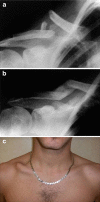Long-term results of conservative management of midshaft clavicle fracture
- PMID: 19669643
- PMCID: PMC2903171
- DOI: 10.1007/s00264-009-0850-x
Long-term results of conservative management of midshaft clavicle fracture
Abstract
A series of 91 patients (59 males, 32 females, mean age 41 years) with middle-shaft clavicle fracture were assessed at a mean of 8.7 years after injury. Based on Allman's classification, fractures were placed in group Ia, Ib and Ic. The majority (66%) were allocated to groups Ib or Ic. Clinical evaluation was made using the Constant score and simple shoulder test. On post-injury radiographs, we measured the amount of overlapping of the fracture fragments (OV) both in centimetres and as percentage of the length of the clavicle and the mean distance between cranio-caudally displaced fragments (DS). The mean Constant scores were 87.1% and 85.6% in groups Ib and Ic, respectively. In patients with a Constant score > or =90%, the mean OV was 7.7% and the average DS was 1.59 cm. In those with a Constant score of 81-89% the average OV and DS were 12% and 1.6 cm, respectively, with the greatest OV being 12.9. In the nine patients whose Constant score was > or =80% the mean OV was 13.2 and the average DS was 1.7; however, the majority of patients had an OV > 15% and DS > or = 2 cm. In these nine patients the mean Constant score was significantly lower than that in the group with a score of > or =90%. The simple shoulder test showed that 20% of patients were dissatisfied with the outcome; a low score was associated with a severe degree of OV or DS. Fracture nonunion occurred in five cases (5.5%). We conclude that there is a clear-cut indication for surgery in patients with OV > or = 15% or DS > or = 2.3 cm as well as in those with an OV > or = 13% associated with a DS > or = 2 cm. This holds particularly for young and middle-aged patients.
Figures


References
-
- Neer C. Fractures of the clavicle. In: Rockwood CA Jr, Green DP, editors. Fractures in adults. 2. Philadelphia: Lippincott; 1984. pp. 700–713.
-
- Robinson CM. Fractures of the clavicle in the adult. Epidemiology and classification. J Bone Joint Surg [Br] 1998;80:467–484. - PubMed
MeSH terms
LinkOut - more resources
Full Text Sources
Medical

